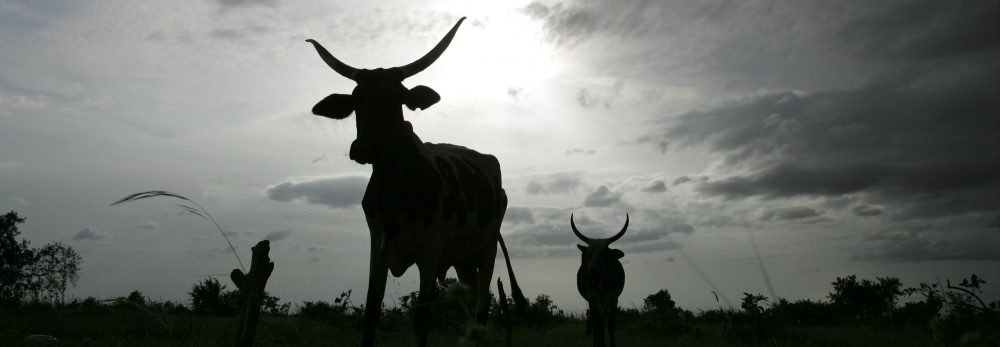Group of 25 experts enters 'uncharted waters' in building futuristic livestock scenarios that force new thinking and new decisions.
The International Livestock Research Institute (ILRI) and the Food and Agriculture Organization of the United Nations (FAO) hosted a group of 25 livestock and futures experts from around the world for two and a half days 13–15 February 2006 to do some non-crystal-ball-gazing. The experts constructed alternative scenarios of likely futures of livestock development in developing countries, paying particular attention to what will happen to poor people.
They got help from, Jerome Glenn, who is an expert in ‘futures research’ and director of a think tank called the Millennium Project, which has been running under the aegis of the American Council for the United Nations University since 1991.
Decision-makers in ILRI and FAO and other livestock research and development institutions are the target of the products of this meeting. The idea behind this work is to force serious, flexible thinking about alternative possibilities for the future and begin to come up with the right mix of strategic decisions that will allow people to adapt to the future. The process of doing this work can alter the way decision makers think about the future. That, says Glenn, may be the most important outcome of the meeting.
‘The germ of a future-oriented collective intelligence on livestock development for the poor was created here,’ Glenn said at the close of the meeting. ‘What we believe is possible for livestock development is “pretty poultry”’, he punned. ‘Here, for example, are just a few of the things that were not yet in the world in 1980: personal computers, the World Wide Web, cellular phones, AIDS, the European Union and the World Trade Organisation. The world has changed dramatically in the last 25 years. What is guaranteed is that we will have even more and faster changes in the future. This meeting was held to enlarge the capacity of stakeholders in livestock development to respond to good and bad events in future, including major shocks such as another tsunami, a war and or disease pandemics.’
Click here to read Jerome Glenn’s paper, Global Scenarios and Implications for Constructing Future Livestock Scenarios, January 2006, 68 pages.
‘We are entering uncharted waters’, said FAO Henning Steinfeld, to develop a platform for creating a better understanding of livestock futures.’
ILRI’s director general, Carlos Seré, said ILRI and FAO share concerns about finding the best ways to position livestock in a dynamic world for the benefit of the poor.
The products of this meeting include a wealth of information embedded in four plausible ‘storylines’ that the participants constructed for the future. The participants adapted the Millennium Ecosystem Assessment scenarios for the livestock sector and used two axis: one defining a future environmentally reactive or proactive, the other defining a future globalized or fragmented. The scenarios the ILRI-FAO meeting participants developed ranged from a ‘Techno-Garden’, where technology is largely a good, benefiting many and bringing people together, to ‘Global Orchestration’, a world where consumers rule—but which consumers?, to an ‘Adaptive Mosaic’ future in which novel uses of IT connect livestock communities, to ‘Order from Strength; Weakness from Chaos’, a future in which where today’s international organizations are largely ineffective or have disappeared altogether, the world is fragmented and reactionary, and its every country for itself.
Summaries of the storylines will be produced by the end of March 2006. A longer report will be produced subsequently by ILRI and FAO. To receive a copy of the summaries or report, contact the meeting’s organizers, ILRI’s Ade Freeman or FAO’s Anni McLeod.
This livestock expert opinion is needed to feed into a major inter-governmental and consultative 3-year effort initiated by the World Bank called the International Assessment of Agricultural Science and Technology for Development. Involving 900 participants and 110 countries, the IAASTD is now collecting global and regional assessments of the state and needs of science and technology and is at the stage of preparing first drafts of results. Results of the ILRI-FAO meeting will also be used to inform annual program meetings of ILRI and the Animal Production and Health Division of FAO, where feedback from wider circles of livestock experts will be sought.
The aim of all this work, says ILRI livestock systems analyst Philip Thornton, is to ‘help build and drive a bandwagon rather than jumping on whatever bandwagon happens along. We need to be changing mindsets in a world where ten percent of the world’s population consumes ninety percent of the world’s resources. It is surely not impossible to have a more equitable world. We need to show people that livestock are a great development tool with which to do that.’
FAO Henning Steinfeld agrees. ‘The livestock sector must respond to the world as it is—and to how the sector is likely to be in the foreseeable future.’
If the world does not view livestock experts as long-term global visionaries, maybe it should take another look.
